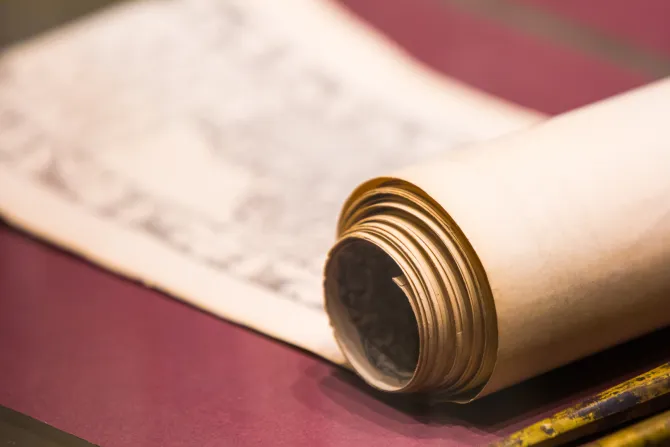Tokyo, Japan, Nov 28, 2018 / 00:24 am
A Christian scroll found in a Japanese museum is believed to be from the earliest days of Christianity in the country, researchers have said.
The scroll measures about 10.5 feet long and about nine inches high, and depicts 15 scenes from the passion, death, and resurrection of Jesus. The pictures include religious figures wearing traditional Japanese garments, and Latin prayers are spelled out in Japanese phonetic letters throughout the scroll.
The scroll was discovered at SawadaMiki Kinenkan museum in the town of Oiso, Kanagawa Prefecture, near Tokyo, which collects historical Christian items.
<blockquote class="twitter-tweet" data-lang="en"><p lang="en" dir="ltr">Centuries-old Christian painting found in Japan <a href="https://t.co/0lly35EfF1">https://t.co/0lly35EfF1</a></p>— NHK WORLD News (@NHKWORLD_News) <a href="https://twitter.com/NHKWORLD_News/status/1064342756099682304?ref_src=twsrc%5Etfw">November 19, 2018</a></blockquote>
<script async src="https://platform.twitter.com/widgets.js" charset="utf-8"></script>
According to Japanese newspaper The Mainichi, an inscription on the scroll reads "1592 years since His Birth," leading historians to believe that this was the year the scroll was created. Carbon dating has dated the scroll as having been created prior to the year 1633, the museum said in a press conference.
If this dating is accurate, the scroll would be from a period of cruel and violent persecution of Christians in Japan.
Christianity arrived to the islands of Japan when St. Francis Xavier came to the country in 1549, though it is possible that Nestorian Christians had arrived at the islands in the 400s, only to retreat some years later.
Francis Xavier and his Jesuit missionaries evangelized and baptized many Japanese, sometimes converting whole provinces to Christianity.
By the 1580s, there were more than 200,000 Christians in Japan, including several influential leaders who had converted. But in 1588, the emperor Cambacundono commanded all Jesuit missionaries to leave the country within six months.
Many missionaries remained in secret, but a time of intense anti-Christian persecution had begun. Christian converts were tortured by burning or flaying of their skin until they renounced their faith. If they refused to renounce, they were usually put to death by burning, beheading, or crucifixion.
Most Europeans were banned from the island at the time, for fear they would try to convert the Japanese to Christianity. In 1642, five Jesuits landed in Japan, but were soon discovered and killed. The Christian faith was prohibited throughout Japan until 1871, when the Japanese people were granted freedom of religion.
The scroll discovered at the museum is one of few Christian artifacts from Japan, as most were destroyed after the faith was banned in 1612.
Osamu Inoue, head of the Yokohama History Museum and one of the people who studied the artifact, said the pictures were likely created in response to the rapid growth of the Christian faith in Japan after the arrival of St. Francis Xavier.
"Ordinary people perhaps drew such pictures on papers because the material was inexpensive and (authentic) religious items were in short supply due to a rapid growth of the follower population," he told The Mainichi.
The scroll is now on display at the museum.
The history of Christianity in Japan has recently received new attention, with the UN recognizing several places of Christian importance in Japan as UNESCO World Heritage sites, and with the 2017 beatification of Justo Takayama Ukon, a Catholic samurai and martyr.
(Story continues below)


